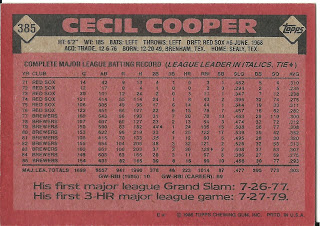Card
thoughts: Cooper sported a variety of facial hair
on his cards. In the 70s, he was fond of the mutasche/long side burns combo. By
the time he came to the Brewers, he took to wearing shaded specs and the neatly
groomed full beard you see on this card.
The
player: Like his teammate (on both the Red Sox
and Brewers) #373 Ben Ogilve, Cooper was blocked for years by a veteran at his
position (in his case, legend Carl Yastrzemerski). But with a batting stance
change (an exaggerated crouch), and a change in scenery, Cooper became a star
in the 80s for the Brewers.
Raised in a large family full of pro baseball
players (both his father and older brothers played in the Negro Leagues).
Drafted out of high school by the Red Sox, he hit .336 with their Midwest League
affiliate (Danville) in 1970, prompting the Cardinals to draft him, but he was returned
at the end of spring training the next year.
Cooper spent a couple of years as the Red Sox’s
primary designated hitter, which was a shame because Yastrzemski was playing
first because he was old, not because he was a good fielder. It was hard to
keep Cooper out of the lineup because he had a good bat, but he got hit in the
face in 1975, and that sidelined him for a while.
Finally finding Cooper’s bat superfluous to their
team, the Red Sox sent him to the Brewers in 1976 for Bernie Carbo (great pinch
hitter, troubled person) and George Scott (a bit over the hill, but had one
great season left in him). Out of the shadow of Fenway, Cooper began to shine.
He hit over .300 in each of his first three Brewer seasons, with an especially
good 1979 season, when he made the all star team, won a gold glove, and led the
league in doubles (44).
In 1980, Cooper would hit .352 and led the league in
RBIs (122). Most years, that batting average would have topped the league, but
George Brett hit .390 that year. Cooper would continue to be consistently
productive until 1984, generally ranking in the top 5 in MVP voting, hitting
over 30 home runs, and driving in over 100. In doing so, he was a favorite in
Milwaukee, even penning a kids’ column in the in-house Brewers organ What’s
Brewing. He also gave back to the community, winning the Roberto Clemente award
for public service in 1983.
1984 was a down year for Copper, as he failed to hit
above .300 for the first time since 1976. In addition, his power numbers were
down (just 28 doubles and 11 home runs). Although he was aging, by the time
this card came out, he had come off a year that a return to form (39 doubles,
99 driven in, and even 10 steals, the most he’d swiped since 1980). But Cooper
would play just one more full year, before retiring early in the 1987 season.
Since retirement, he’s worked as a sports agent,
farm director, scout, and manager (most recently for the Houston Astros). Cooper
is still one of the greatest Brewers off all time, and although not of Hall of
Fame caliber, he comes close.
Rear guard: I wonder if Topps picked these dates because they were almost exactly two years apart? Well, I don't know what day his first grand slam was, because on July 26th, Cooper went 0-4 with 2 strikeouts.


No comments:
Post a Comment